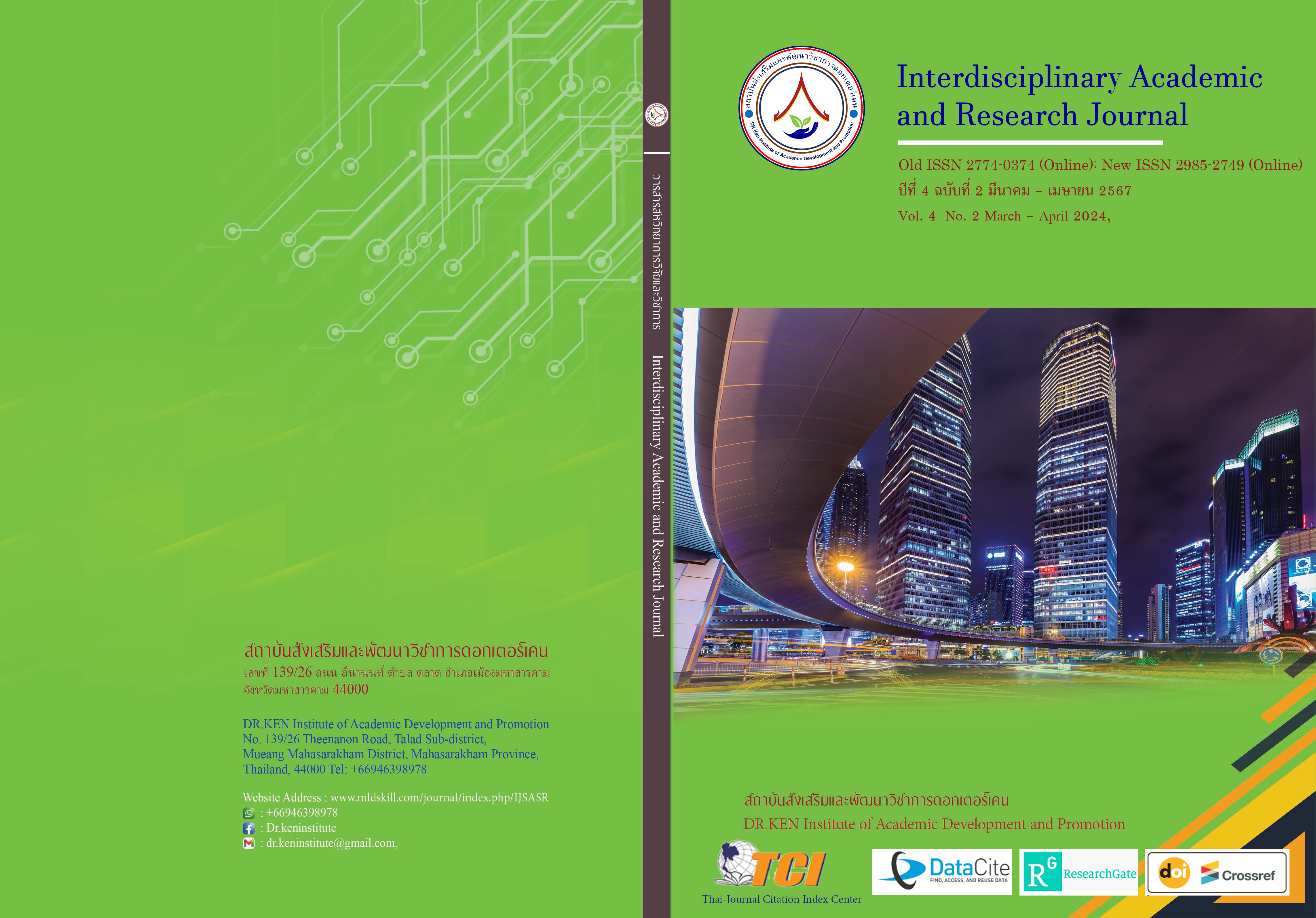Organizational Culture and Strategic Management Affecting Performance Results the Operational Efficiency of Office of Public Prosecutors Region 4
DOI:
https://doi.org/10.60027/iarj.2024.274908Keywords:
Organizational Culture; , Strategic Management; , Stock Exchange of ThailandAbstract
Background and Aims: One of the most important factors affecting organizational effectiveness and management success is organizational culture. In addition, strategic management is another factor that affects the success of the organization's management. Strategic management is systematic management that relies on the vision of the organization's leaders as a component and relies on Step-by-step planning. Thus, the purposes of the study included the following: 1) To Study the Level of the Organizational Culture and Strategic Management and Performance results in the Operational Efficiency of Office of Public Prosecutors Region 4 2) To study the influence of the Organizational Culture and Strategic Management and Performance results in the Operational Efficiency of Office of Public Prosecutors Region 4.
Methodology: The sample group consisted of 278 personnel of the Prosecutor's Office Region 4 using a stratified sampling method. Using a questionnaire as a tool in collecting data Statistics used in data analysis include frequency, percentage, mean, and standard deviation. and multiple regression analysis.
Results: (1) The overall organizational culture of the Office of Public Prosecutors Region 4 Overall, was at a high level, the strategic management of the Office of Public Prosecutors Region 4 Overall, was at a high level, and the performance of the Office of Public Prosecutors Region 4 Overall, was at a high level. (2) Organizational culture variables can together predict the level of performance of Office of Public Prosecutors Region 4 at 53.50 percent (R2Adj=.535) with statistical significance at the .01 level. When considering the sub-components of organizational culture variables, it was found that the variables with The highest regression coefficient were mission culture (β=.554), followed by participatory culture (β=.354), unity culture (β=.224), and adaptive culture (β=.188), respectively. (3) The strategic management variables can together predict the performance level of the Office of Public Prosecutors Region 4 at 85.50 percent (R2Adj=.855) with statistical significance at the .01 level when considering the sub-components of the strategic management variables. It was found that the variables with the highest regression coefficients were strategy implementation (β=.560) and environment monitoring (β=.484), respectively, except for the strategy formulation variable. and strategic control and evaluation.
Conclusion: The assessment of the Office of Public Prosecutors Region 4 indicates a positive organizational environment characterized by high levels of overall organizational culture, strategic management, and performance. The study highlights the significant predictive role of mission culture in the organizational culture domain and emphasizes the importance of strategy implementation and environment monitoring in strategic management. These results underscore the integrated influence of organizational culture and strategic management on the overall performance of the Office of Public Prosecutors Region 4, suggesting a robust and well-aligned organizational framework.
References
จิราพรรณ สุดลาภา. (2564). วัฒนธรรมองค์การ และภาวะผู้นำเชิงกลยุทธ์ที่ส่งผลต่อการบริหารมุ่งผลสัมฤทธิ์ขององค์กรปกครองส่วนท้องถิ่นในเขตอำเภอเมืองจังหวัดนครพนม. วิทยานิพนธ์รัฐประศาสนศาสตรมหาบัณฑิต มหาวิทยาลัยราชภัฏสกลนคร.
ทนงศักดิ์ บัวยิ้ม. (2563). วัฒนธรรมองค์การที่มีผลต่อประสิทธิภาพการทำงานของข้าราชการฝ่ายอัยการสำนักงานอัยการสูงสุด. สารนิพนธ์รัฐประศาสนศาสตรมหาบัณฑิต มหาวิทยาลัยศรีปทุม.
ประกอบ คงยะมาศ. (2562). วัฒนธรรมองค์กรและการบริหารแบบมุ่งผลสัมฤทธิ์ที่ส่งผลต่อประสิทธิผลการดำเนินงาน ขององค์กรปกครองส่วนท้องถิ่นในจังหวัดหนองบัวลำภู. รายงานการวิจัย วิทยาลัยพิชญบัณฑิต.
ประกาศคณะกรรมการอัยการ, (2554). ประกาศคณะกรรมการอัยการ เรื่อง การแบ่งหน่วยงาน และการกําหนดอํานาจและหน้าที่ของหน่วยงานภายใน ของสํานักงานอัยการสูงสุด พ.ศ. 2554. ราชกิจจานุเบกษา เล่ม 128 ตอนที่ 66 ก, 2 กันยายน 2554
พระมหาสิทธิศักดิ์ สิทฺธาภิรโต (เสนา) (2561). การบริหารแบบมุ่งผลสัมฤทธิ์ของเทศบาลเมือง เพชรบูรณ์จังหวัดเพชรบูรณ์. สารนิพนธ์รัฐประศาสนศาสตรมหาบัณฑิต สาขาวิชารัฐประศาสนศาสตร์: มหาวิทยาลัยมหาจุฬาลงกรณราชวิทยาลัย.
ยุภาพร รัตนบุรี. (2561). ปัจจัยสภาพแวดล้อมที่มีความสัมพันธ์กับผลสัมฤทธิ์ของการบริหารทรัพยากรมนุษย์ด้านธุรการ ของสำนักงานอัยการสูงสุด. วิทยานิพนธ์รัฐประศาสนศาสตรมหาบัณฑิต มหาวิทยาลัยสุโขทัยธรรมาธิราช.
ฤมล สอนดี. (2561). การบริหารเชิงกลยุทธ์ที่ส่งผลต่อการดำเนินงานการประกันคุณภาพภายในของโรงเรียนมัธยมศึกษาของรัฐในจังหวัดราชบุรี. วิทยานิพนธ์ครุศาสตรมหาบัณฑิต มหาวิทยาลัยราชภัฏนครปฐม.
วิชาญ อิทธิฤกษ์มงคล. (2564). การบริหารเชิงกลยุทธ์ที่ส่งผลต่อประสิทธิภาพการจัดการสาธารณภัยขององค์กรปกครองส่วนท้องถิ่น ในเขตพื้นที่รอบหนองหารอำเภอเมืองสกลนคร จังหวัดสกลนคร. วิทยานิพนธ์รัฐประศาสนศาสตรมหาบัณฑิต มหาวิทยาลัยราชภัฏสกลนคร.
วิทยาธร ท่อแก้ว. (2564). การสร้างวัฒนธรรมองค์กร. นนทบุรี: มหาวิทยาลัยสุโขทัยธรรมาธิราช.
ศรีสกุล เจริญศรี. (2562). วัฒนธรรมองค์การกับประสิทธิผลองค์การของสำนักงานยุทธศาสตร์ตำรวจ สำนักงานตำรวจแห่งชาติ. รายงานการวิจัย กองยุทธศาสตร์ สำนักงานยุทธศาสตร์ตำรวจ สำนักงานตำรวจแห่งชาติ.
ศิริลักษณ์ ฉัตรเจริญทรัพย์. (2564). วัฒนธรรมองค์การที่มีผลต่อการปฏิบัติงานของบุคลากร : กรณีศึกษา สำนักงานคณะกรรมการอัยการ สำนักงานอัยการสูงสุด. การค้นคว้าอิสระรัฐประศาสนศาสตรมหาบัณฑิต: มหาวิทยาลัยรามคำแหง.
สถิตย์ จันทร์น้อย. (2565). การบริหารเชิงกลยุทธ์นโยบายกับการเมืองและผลกระทบการกระจายอำนาจต่อการกำกับดูแลท้องถิ่นในประเทศไทย. รายงานการวิจัย มหาวิทยาลัยมคธ.
สำนักงานข้าราชการพลเรือน. (2555). คู่มือการกำหนดสมรรถนะในราชการพลเรือน: คู่มือสมรรถนะหลัก. กรุงเทพฯ: ประชุมช่าง.
สำนักงานอัยการภาค 4, (2565). ข้อมูลจำนวนบุคคลากรของสำนักงานอัยการภาค 4. สำนักงานอัยการภาค 4
สำนักงานอัยการสูงสุด, (2562). รายงานประจำปี 2562 สำนักงานอัยการสูงสุด. กรุงเทพฯ : สำนักงานอัยการสูงสุด
สิน พันธุ์พินิจ. (2554). เทคนิคการวิจัยทางสังคมศาสตร์. กรุงเทพฯ: บริษัทวิทยพัฒน์ จำกัด.
สินีนาฏ ทิพย์มูสิก. (2561). การบริหารเชิงกลยุทธ์ของหอผู้ป่วย โรงพยาบาลระดับตติยภูมิ สังกัดกระทรวงสาธารณสุข. วิทยานิพนธ์ประชญาดุษฎีบัณฑิต มหาวิทยาลัยคริสเตียน.
อทิตยา วิโรจนะ. (2566). อิทธิพลของวัฒนธรรมองค์กรที่ส่งผลต่อประสิทธิภาพการปฏิบัติงาน ของข้าราชการธุรการสำนักงานอัยการภาค 9. สารนิพนธ์ฐประศาสนศาสตรมหาบัณฑิต มหาวิทยาลัยสงขลานครินทร์.
Barney, J. (1991). Firm resources and sustained competitive advantage. Journal of Management, 17(1), 99–120.
Cameron, K.S., & Quinn, R.E. (2006). Diagnosing and changing organizational culture: Based on the competing values framework. John Wiley & Sons.
Denison, D.R. (1990). Corporate culture and organizational effectiveness. John Wiley & Sons.
Denison, D.R., Haaland, S., & Goelzer: (2003). Corporate Culture and Organizational Effectiveness: Is There a Similar Pattern Around the World? Advances in Global Leadership. 3, 205-227.
Kotter, J.P., & Heskett, J.L. (1992). Corporate culture and performance. Free Press.
Krejcie, R.V., & Morgan, D.W. (1970). Determining Sample Size for Research Activities. Educational and Psychological Measurement, 30(3), 607-610
Porter, M.E. (1996). What is strategy? Harvard Business Review, 74(6), 61–78.
Schein, E.H. (2010). Organizational culture and leadership. John Wiley & Sons.
Sergiovanni, T.J., & Starratt, R.J. (1988). Supervision: Human Perspectives. New York: McGraw-Hill.
Thompson, A.A., & Strickland, A.J. (2019). Strategic management: Concepts and cases. McGraw-Hill Education.
Wheelen, T.L., & Hunger, J.D. (2006). Strategic Management and Business Policy. New Jersey: Prentice Hall.
Downloads
Published
How to Cite
Issue
Section
License
Copyright (c) 2024 Interdisciplinary Academic and Research Journal

This work is licensed under a Creative Commons Attribution-NonCommercial-NoDerivatives 4.0 International License.
Copyright on any article in the Interdisciplinary Academic and Research Journal is retained by the author(s) under the under the Creative Commons Attribution-NonCommercial-NoDerivatives 4.0 International License. Permission to use text, content, images, etc. of publication. Any user to read, download, copy, distribute, print, search, or link to the full texts of articles, crawl them for indexing, pass them as data to software, or use them for any other lawful purpose. But do not use it for commercial use or with the intent to benefit any business.
















.png)


